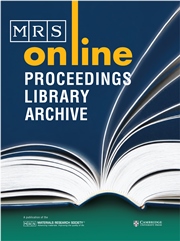Article contents
Electronic Structure of AgPbmSbTem+2 Compounds – Implications on Thermoelectric Properties
Published online by Cambridge University Press: 01 February 2011
Abstract
Novel quaternary compounds AgPbmSbTem+2 (LAST-m) with different m values have been synthesized recently and some of these compounds show promising thermoelectric properties at high temperatures. The two end members of the series, PbTe (m=∞) and AgSbTe2 (m=0), are also known to be good thermoelectrics. In this paper, we discuss the results of ab initio electronic structure calculations for these two end members and for LAST-2 and LAST-14 to see how the electronic structure near the chemical potential μ evolves with m. Whereas PbTe and LAST-14 are narrow band gap semiconductors, the other two compounds show pseudo-gap structure. Even in the absence of a true gap, the rapidly varying density of states (DOS) near μ may be conducive to large Seebeck coefficient in LAST-2 and AgSbTe2.
- Type
- Research Article
- Information
- Copyright
- Copyright © Materials Research Society 2006
References
REFERENCES
- 1
- Cited by




